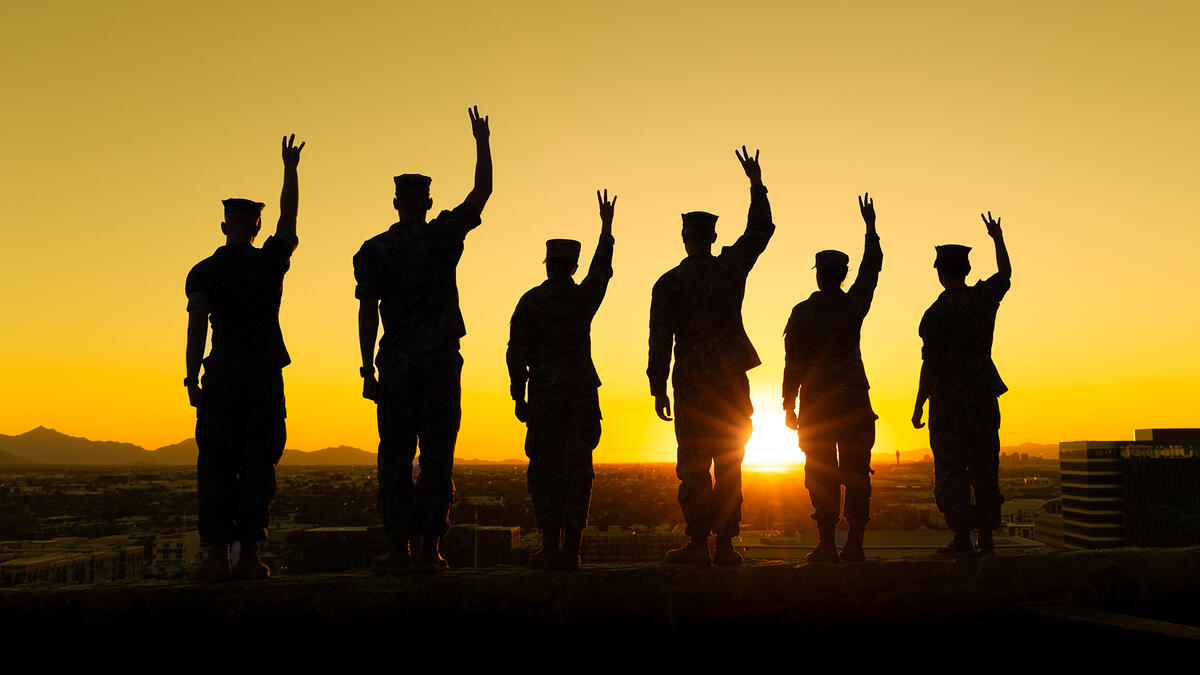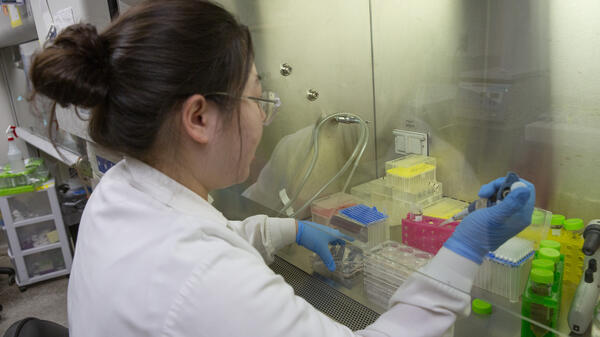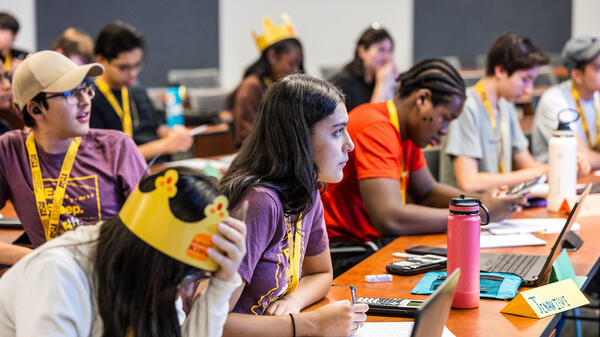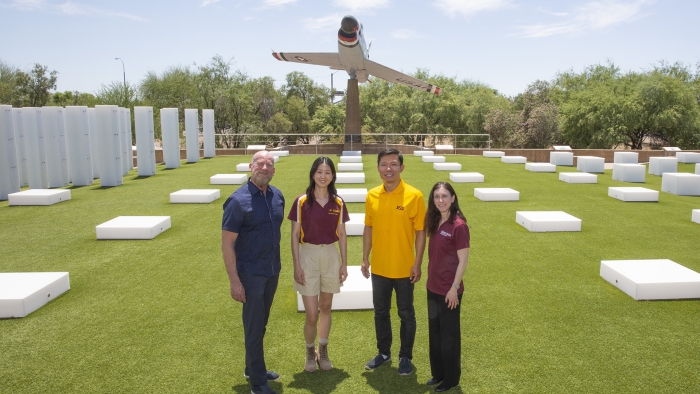No one left behind: AI-enabled support for aging vets
Cross-disciplinary ASU research team develops tech tools to combat social isolation in retired military personnel

ASU active-duty military personnel salute the sunset. A cross-disciplinary team of four researchers working across four campuses at Arizona State University has united to create artificial intelligence solutions to improve health care outcomes for aging U.S. military veterans. ASU photo
Loneliness has been called the silent killer.
The U.S. surgeon general has described the negative health effects of social isolation as being as damaging as smoking cigarettes. While many aging Americans are at risk of feeling or being socially isolated, veterans are particularly vulnerable.
That's why Nicole Roberts, an associate professor of psychology in the School of Social and Behavioral Sciences at Arizona State University, has spent the last few years studying how to improve health care outcomes for veterans. She notes that Americans who have served in the military often suffer from medical conditions that are the result of serving in combat or performing highly physical jobs. Some vets have spent significant amounts of time living in close quarters on bases and later with a structured lifestyle, leaving them uniquely impacted when they find themselves retired and alone.
Roberts also says many veterans have been especially driven by the spirit of providing service to their communities.
“In many ways, veterans are the epitome of being active contributors earlier in their lives,” Roberts says. “When they transition into older age, many continue making these active contributions, but others suffer from serious health conditions that can make them feel marginalized and isolated.”
To tackle this problem, Roberts enthusiastically agreed to join forces with Ming Zhao, an associate professor of computer science and engineering in the School of Computing and Augmented Intelligence, part of the Ira A. Fulton Schools of Engineering at ASU.
Together they are part of a cross-disciplinary team of researchers who have been awarded a grant from the National Science Foundation, or NSF, to develop artificial intelligence, or AI, tools for edge devices that will improve health care outcomes for aging veterans.
The project builds on Zhao’s previous work developing machine learning systems that integrate health care information into user-friendly tools and interfaces for older adults. He assembled a team that includes Roberts, David Coon, associate dean of research initiatives, support, and engagement and a professor in the Edson College of Nursing and Health Innovation, and Erin Chiou, an associate professor of human systems engineering in The Polytechnic School. They came together to research how veterans can not only survive but thrive by becoming more empowered and gaining greater access to social and community relationships.
Staying independent but also connected
The project supported by the grant is called “EdgeCare,” or Engagement for older adults via Data-Generated Efficacy.
Edge devices are small electronics, like cellphones, smartwatches and doorbell cameras that are becoming an important part of day-to-day life. Many people already use certain edge devices like Fitbits and Oura Rings to stay active and help improve their health. These devices can monitor heart rate, steps walked and quality of sleep, and then make recommendations to the wearer.
Creating new AI technology for edge devices is an emerging focus for researchers, including those at ASU who are developing machine learning systems for electronics used by health care professionals in hospitals. In recent years, Zhao’s research lab team has advanced edge computing in other sectors, including doing important work to reduce stress for law enforcement officers.
Zhao explains that his team is essentially trying to create an AI-powered digital assistant that will run on a small device in the veteran’s home. EdgeCare will connect to the cloud to have access to important information, like language libraries and medical databases, but personal information will only be stored on the user’s device for security and privacy.
“First, the device will collect data about the veteran,” Zhao says. “Then, it will learn from the data it gathers. Finally, the system can provide an intervention to help the user.”
Veterans will be able to enter information about their health, such as chronic conditions and the prescription medications they rely on. Like many fitness trackers, Zhao’s system will be able to gather information like movement and health metrics. Then, the AI-powered assistant will learn how to be helpful. EdgeCare might automatically promote memory exercises, suggest physical workouts, encourage the veteran to reach out to friends to improve emotional well-being or recommend community activities.
And the device will watch for changes in patterns of behavior. If the veteran becomes less active, spends less time outside the house or becomes less communicative, the AI system will alert a medical professional or loved one who can check in. This could provide critical, early intervention for veterans dealing with memory issues or worsening health conditions.
“The project is about helping veterans stay independent,” Zhao says. “But when they need help, they can get help.”
Roberts agrees, saying, “We now know that lack of social connection, as well as lack of exercise, mental stimulation and even sleep can increase dementia risk. So early tracking of cognitive and emotional changes can help veterans get care at earlier stages of cognitive decline.”
Cross-disciplinary team combines expertise to deliver results
What’s especially unique about this NSF-funded project is that it brings together a group of diverse researchers who will combine their expertise. Along with Roberts, Coon — who serves as the director of The Center for Innovation in Healthy and Resilient Aging — will address the social, interpersonal and cultural aspects of the project, ensuring that the artificial intelligence system takes a holistic approach to veterans’ health needs.
Because it’s especially important to create technology that veterans will want to interact with, Zhao and the team have tapped Chiou for her considerable expertise in human–automation interaction. She’ll work to better understand the day-to-day activities of veterans and their care partners at different stages in life to determine how technology is used and how its effectiveness might be improved.
Working with a team of students to gain insights from focus group data, Chiou will then make recommendations about the design of the new EdgeCare system that is rooted in the study of veterans’ needs.
Zhao, meanwhile, will turn his attention to the study and development of distributed machine learning methods, the type of AI that will power EdgeCare. His work, which aligns with his efforts at the Center for Accelerated Real Time Analytics, will focus on the need for highly accurate, speedy and secure algorithms that can combine broad information from the cloud with personal data from the user’s device.
“YZ” Yezhou Yang, an associate professor of computer science and engineering in the School of Computing and Augmented Intelligence, an expert in computer vision research, will also provide additional support.
The group will combine their clinical, psychological, social and technical acumen to improve health and well-being support for veterans
On the front lines of change
EdgeCare will also create new technology to foster interaction between veterans, their families and their caregivers. Roberts believes the project is well aligned with initiatives from the U.S. Department of Veterans Affairs to improve health care outcomes for its members, and she has been inspired by the response from veterans thus far. She says that many of the participants in early studies were enthusiastic about using new technology if it could help improve their health — and more importantly, the health of fellow veterans.
“I think it’s surprising that people who we might think would be resistant to new technology are, in fact, very open to it because they really want solutions,” Roberts says.
She was also inspired by the dedication of many of the veterans to fellow military members, noting that many expressed interest in connecting with other vets and maintaining a sense of community.
Zhao is also hopeful that the project can be of benefit for other groups, providing solutions to dealing with fast-growing, aging populations.
Ross Maciejewski, director of the School of Computing and Augmented Intelligence, appreciates Zhao’s efforts to bridge research domains to solve a critical problem.
“This work is an interesting example of using artificial intelligence to tackle an under-resourced problem, actually using technology to foster interaction between veterans, their communities and their caregivers,” Maciejewski says.
More Science and technology

Chilling discovery: Cold-sensing protein may pave the way for safer pain relief
For millions of people worldwide who live with chronic pain, the only treatments currently available often rely on opioids, which carry the risks of addiction and overdose. However, new research…

Harnessing benefits of stem cells for heart regeneration
Mehdi Nikkhah, an associate professor of biomedical engineering in the Ira A. Fulton Schools of Engineering at Arizona State University, and his collaborators at Mayo Clinic in Arizona have been…

Newly accredited ASU summer program opens up STEM opportunities for underrepresented students
It was Monday afternoon. Spotify was playing pop music in the background and the instructor stood behind a lectern wearing a paper Burger King crown. It is not a scene one would expect in a college…
